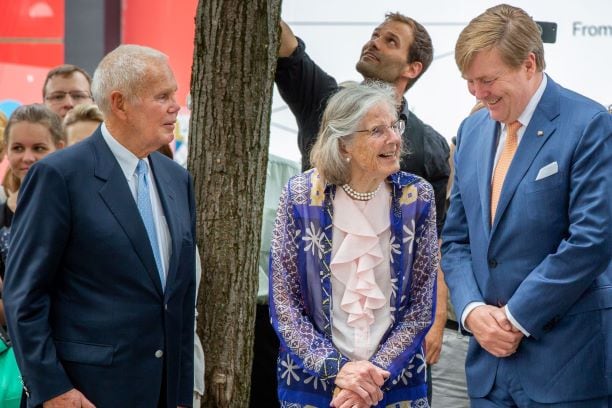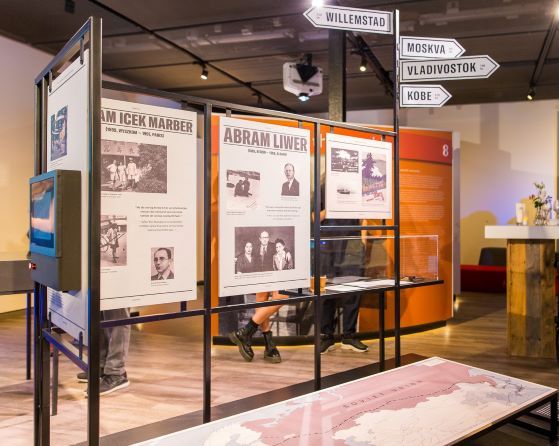Jan Zwartendijk: a story that cannot be forgotten
The name Jan Zwartendijk will not sound familiar with everyone, but 'Mister Radio Philips' saved thousands of Jews during World War II by providing them with a 'false' visa. Olga Coolen, director of the museum, talks about it.
Rats in a trap
When Lithuania was overrun by the Red Army in spring 1940, this branch manager of a Philips radio factory in Kaunas was approached by the Dutch ambassador of Latvia with the question if he wanted to temporarily assume the position of honorary consul. Zwartendijk accepted, figuring that there would surely only be a handful of Dutch people he would have to help leave the country. But then he ran into Nathan Gutwirth, a Jewish Dutchman with whom he occasionally exchanged newspapers and soccer reports. 'Nathan told him that many Jewish acquaintances wanted to leave the country, but had nowhere to go because surrounding countries had closed their borders to refugees,' Olga says. 'People were trapped like rats and, ironically, were more afraid of the communist Russians than the Germans. After all, that was a 'civilized people,' you didn't have to expect much misconduct from them.'

Life on the line
The escape route devised by Zwartendijk and Gutwirth was via the Trans-Siberia Express to Vladivostok and from there to Japan. From Japan, refugees would then cross to Curaçao, which would be the route's final stop. 'For days Jan wrote out visas, long lines of people stood in front of his office on Freedom Avenue in Kaunas, where a monument has now been erected to honor him. He issued at least 2139 visas, but the number of people saved is much higher, because children traveled with their parents and many visas were copied illegally. Even after the consulate closed, Jan continued to issue visas, as Jan Brokken discovered while writing his book “’The Justified’. In doing so, he put his own life on the line to save as many others as possible.'
Thousands of survivors
Eventually Zwartendijk no longer felt safe and returned to Holland, where he had to fear for four more years that the Nazis would arrest him because of his activities in Lithuania. After the war he was reprimanded by Minister Luns for falsifying visas: to enter Curaçao you needed permission from the governor, and Zwartendijk had cleverly omitted that phrase. So a ribbon of honor was out of the question, although his relatives received an official apology from the Ministry of Foreign Affairs in 2018. Yet this is not what bothered Zwartendijk for the rest of his life. What really tormented him was the uncertainty about the fate of the thousands of people he had issued visas to. 'Jan had no idea whether he had unintentionally driven all those people to their deaths,' says Olga. 'He died in 1976, and the tragic thing is that a week after his death, a notice came in from the Holocaust Research Center. It said that 95 percent of 'Jan's refugees' had survived the war. The names of 3080 people are known, but the Wiesenthal Center calculated that at least six thousand Jews were saved thanks to Zwartendijk's visas.'
Japanese Spring
One such survivor was Abraham Liwer, the Jewish owner of a bicycle factory who was considered a capitalist by the Communists. When he arrived in Vladivostok during his escape, he discovered that his wife and daughter had been imprisoned in a Siberian labor camp. For weeks he had to put in a lot of effort, but eventually he got the local authorities to write a letter to Moscow and his wife and daughter were released. Another survivor was Marcel Weijland, just twelve years old at the time. After fleeing Poland in September 1939, his family got in touch with Jan Zwartendijk in June 1940. Olga herself sought contact with 91-year-old Weijland. 'What struck me so much about his story was that he was a very ordinary child, who could even look back on that terrible time with nostalgia. For example, he remembered his own amazement at the Japanese spring, with all those cherry blossoms. And the fun he had at a temporary school in Vilnius. After the attack on Pearl Harbor, Marcel and his family ended up in a Japanese camp, and in 1946 he finally got on a boat to Sydney, where he has always stayed.

A moving encounter
Olga met more people who owed their lives, directly or indirectly, to Zwartendijk. For example, on a flight to Lithuania, where a monument for Zwartendijk was to be unveiled, she sat next to a woman who turned out to be the granddaughter of Abraham Liwer. The woman had just retired and had delved into her family history for the first time. And when Olga arrived in Kaunas, there were also Jan's children and Marcel Weijland, the man who marveled at the Japanese spring blossoms as a child. 'That meeting was so moving. He, representing all the survivors. And they, the children of the resistance hero. They sat very close together, holding hands, and the deep gratitude was just palpable. It really gave me goosebumps, and I was completely out of there, of course. Everything revolved around them and the past that became tangible again for a very short time. That touched me very much.

Exposition 'Visas to Freedom'
The meeting in Kaunas was a confirmation for Olga that the exhibition Visas to freedom had to be conceived. The exhibition was on display at the Philips Museum from September 2018 through March 2023 and can still be viewed today at the Veterans Foundation Brabant Zuid Oost. 'With the exhibition, I wanted to bring the story close. I am happy with the form in which we have cast it. Especially the testimonies of the survivors on the podcasts still touch me deeply. The great thing is that in 2022 in Eindhoven, an artwork of lighting was unveiled for Jan and all the resistance heroes. It remains a piece of Philips history. Naturally, it wasn’t Philips that saved those thousands of human lives, but Jan did go down in history as Mister Philips Radio. That he was so brave and selfless remains something to be proud of. We had to tell his story. The exhibit "Visas to freedom" consisted of a few pots of ink, a real radio from the era, some original documents and letters and the Yad Vashem award Jan Zwartendijk received after his death. The exhibit wasn't necessarily large, but it resonated with the impressive history of this resistance hero and the people he saved from certain death. The stories of three survivors, captured in podcasts, also bring the history to life in moving ways.
Mini-lecture on Jan Zwartendijk
The Philips Museum has since developed a half-hour mini-lecture so that the story can continue to be told.

